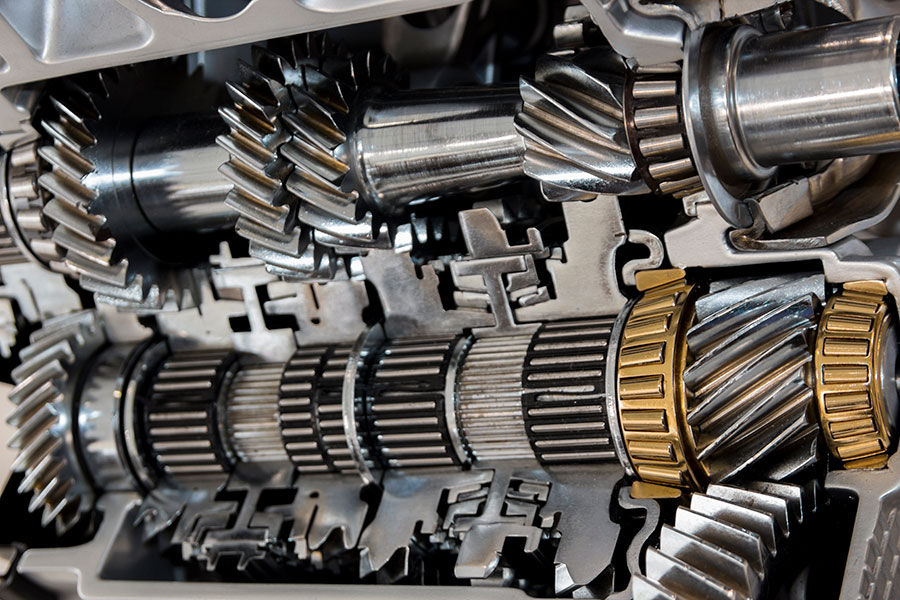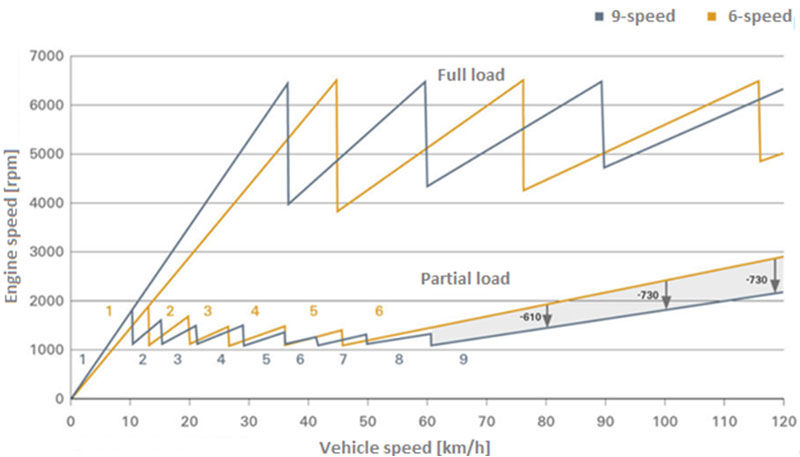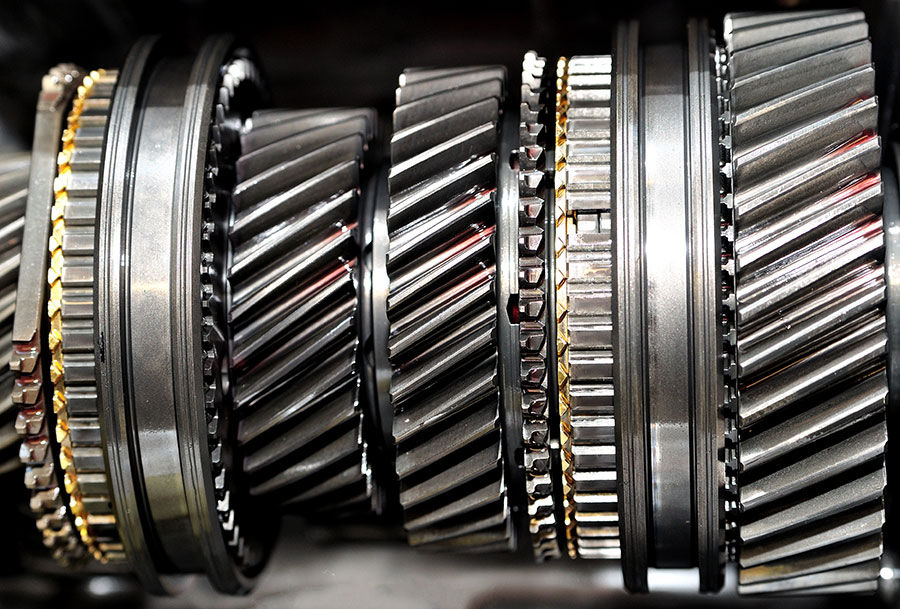Furthermore, within worm-gear reducers, so much heat is produced that designers must address pressure equalization between the inside of a reducer and the atmosphere. Installing a breather valve, which allows air in and out of the reducer is one means of pressure equalization. However, contaminants can also be let into the reducer, as can moisture, which results in oil breakdown and faster reducer failure. Including a bladder inside the reducer, to equalize pressure, is another method of pressure equalization. This can be problematic as well because bladders are likely to rupture and lead to reducer failure.
Another type of gearing is called spur gearing. It is less challenging and costly to machine as opposed to helical gearing, but more expensive than worm gearing. Basically efficient, spur gears have teeth with rolling, instead of sliding, friction, rendering heating a non-issue. Spur gears, on the other hand, have limited tooth engagement between mating gears. This places more force on individual teeth, decreasing the torque-carrying allotment of gearboxes. The teeth begin to be worn down by these factors, in addition to deforming or deflecting the teeth, which restricts the life of the gear. High torque ripple is also created by this limitation as the teeth meet and retreat, resulting in loud gearboxes.
Figure 1: Comparison of six-speed and nine-speed automatic (The partial load line shows that at the same speed, the engine coupled with the 9-speed transmission runs at a lower speed. This saves friction and fuel. At full load, it can be seen that the narrower gradation of the gears allows the maximum power to be driven more often, which benefits the acceleration).
New innovations in gearboxes are integral to a more environmentally friendly and sustainable future. The automotive industry increased over the years from 4–5 speeds to 8–10 speeds in order to close the gap between CVTs, toroidal gears, and electric vehicles (EVs). The new generation of gearboxes make it possible to reduce CO2 emissions by up to five grams per kilometer by optimizing the roller bearings and minimizing the friction of seal lips. This new cutting-edge, green technology has been developed by Volkswagen. It is the manual gearbox, the MQ281 as it is called. This efficient gearbox was initially installed in the new Passat, with almost all other Volkswagen models to follow suit. Up until this time, manual gearboxes had receded into the background. It is now remarkably being noted that only modest alterations were necessary to boost efficiency and improve consumption, resulting in a significant effect on emissions and the environment. These often overlooked and underestimated; manual gearboxes make up a prominent allotment of the gearbox market globally owing to a high installation rate.
This new design is bolstered on a 2.5 shaft concept and touts a high gear spread capped at 7.89 and a torque spectrum of 200 to 340-newton meters. While this ensures a satisfactory driving performance, including for heavy vehicles with bulky wheels, it also enables “down speeding” which is (fuel-saving) driving in high gears with low engine speed. The main impetus for this latest gearbox is primarily to improve efficiency. In addition, a bearing concept was also adapted to the gearbox, in order to mitigate friction. This design employed friction-minimized bearings in tandem with low-contact seals. Furthermore, material use and its distribution for the gearbox casing was also ameliorated. A strength-optimized housing could also be designed with the assistance of a further virtual development tool. The new encasement upholds the noise requirements of today, such as avoidance of unwanted secondary sounds. It, thus, promises increased driving comfort by facilitating less audible and discernable vibrations in the vehicle.
Even with this advancement from Volkswagen, it still should be noted that manual (standard) transmission vehicles only make up around 3% of all vehicles sold in the US. They even have a loyal group of customers that can benefit from the usually smaller production costs as compared to automatics. However, manufacturers are even starting to phase them out. A significant reason for this is to cut out manufacturing costs in general by getting rid of a possible design choice. Also, standard transmissions used to be more attractive due to fuel efficiency, but after recent advancements in automatics, this fact is no longer always the case.
There have been shifts by automakers to go for automatic transmissions to have a higher number of gears, sometimes even going between 8 and 10 speeds. These higher numbers of gears allow for more smooth acceleration and can also improve efficiency. Mercedes Benz took these advancements seriously when they announced their 9G-TRONIC 9-speed automatic transmission in 2013. This transmission has a gear ratio spread of 9.15, which helps to reduce the engine speed and helped lead to an average fuel economy of 44 mpg. Also, the transmission offers up to 1,000 newton meters of transfer torque. They say that the 9G takes up the same volume of space as the 7-speed that came before, but the 9G is lighter than this previous transmission. In addition to Mercedes, Ford and General Motors paired up to create a 10-speed automatic transmission, and Ford alone made an 8-speed automatic, both of which will aim to increase efficiency. It has been reported that the Ford 8-speed will allow for adaptive cruise control, adjust gear shift timings based on inclines, declines, and curves, and will also adjust clutch pressure based on factors both outside and inside the vehicle.
Many manufacturers have also opted for different transmissions entirely, such as the continuously variable transmission (CVT). CVTs are known to give the same fuel efficiency as standard high-speed automatic transmissions and adds in even more smooth gear ratio transitions. This is because instead of having fixed gears and gear ratios, the CVT goes through a continuous range of gear ratios to get to the perfect one for the exact driving condition. This offers some advantage to standard automatic transmissions because, in standard gearboxes, the best gear ratio for a specific driving condition may be in between two fixed gear ratios. Nissan has developed a CVT known as XTRONIC that is designed for engines of 1.5L or 2L. They claim that it has a gear reduction ratio spread of 6 and that it shifts gears 30% quicker than its predecessor.
The topic of CVTs is important when considering purely EVs. Many people have been worried about the range of EVs being too short because batteries currently do not have enough energy density and storage capacity. A group of researchers from Australia and China carried out a study in 2018 about addressing the needs of EVs by using both CVTs and multi-speed dual-clutch transmissions (J. Ruan, et al, 2018). They determined that CVTs provide much potential for use in EVs based mostly on energy usage and fuel consumption. They showed that for a certain class of EVs, one through four-speed transmissions had consumed electricity ranging from 17.8 kWh to 15.1 kWh, respectively, while the CVT consumed electricity of 13.6 kWh, all in a city/highway combined cycle. The CVT also showed the lowest required battery capacity out of all the transmissions at 34 kWh for a range of 200 km. This is all very key information due to the inevitable advent of purely electric vehicles in the worldwide automotive market.
Another arena where the next-generation gearboxes success is critical is with the future of wind power. Although, many industry insiders are pondering if the pace of development is sustainable or if experts are biting off more than they can chew when it comes to technology. Windpower Monthly, in cooperation with wind turbine experts, Moventas, hosted an extended discussion on gearbox innovation at WindEurope 2019. It was attended by participants from prestigious companies such as GE, Acciona, Siemens Gamesa, Ingeteam, ABB, Innogy and Wood Mackenzie. The various segments in the supply chain were represented during the discourse.
Increasingly, wind turbines are being designed with low-wind conditions at the fore. Because of this factor, there is an increase in AEP expectations, rotor diameters, tower height and torque requirements. The question was posed to attendees at the event by Windpower Monthly editor, Shaun Campbell, inquiring as to whether the industry is nearing logistical and transport limits in terms of the installation, movement, and maintenance of very large components.










